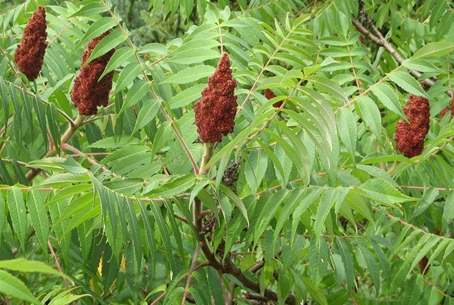Categories
Calendars
Guides
Reviews
Archive
Gallery
Articles
Ask Our Gardening Expert
Sumach
It can reach 8m in height but is normally a lot less in normal gardens. It can withstand temperatures down to -25oC. The leaves are pinnate, narrow and growing from a central rib, a deep green in summer turning to flame red, crimson and purple shades in autumn. After leaf fall, the new spring growth is covered with fine hairs giving the appearance of velveted deer antlers (stag horn sumach). Unfortunately for some, the fine hairs are a skin irritant.
Stagshorn Sumach in bloom
Sumachs originate in temperate regions of North America and Africa. The panicles of flowers develop into waxy, conical seed heads that can be used as candles when a wick is threaded through them. The berries are dried, ground to a powder and used as a citrus-flavoured spice the Middle East.
How to grow Sumach
Sumach sucker well and their seeds are carried by birds. They are difficult to remove and can become a nuisance. They grow easily in any moist, well drained soil. Plant in full sun for the best autumn colours. They can be propagated from root cuttings and stratified seed.
SUMACH AT GLANCE
The sumach, or wax tree is a low, flat-topped tree that has some of the most brilliantly coloured autumn foliage. It is often seen as a multi-stemmed shrub but is best grown as a standard by training and pruning one or two stems when young. 
Latin name Rhus toxicodenron (poison ivy) and Rhus typhina(stagshorn)
Type
Deciduous tree or woody shrub
How to grow
Plant in moist, well drained soil
Propagation
Root cuttings, stratified seed.